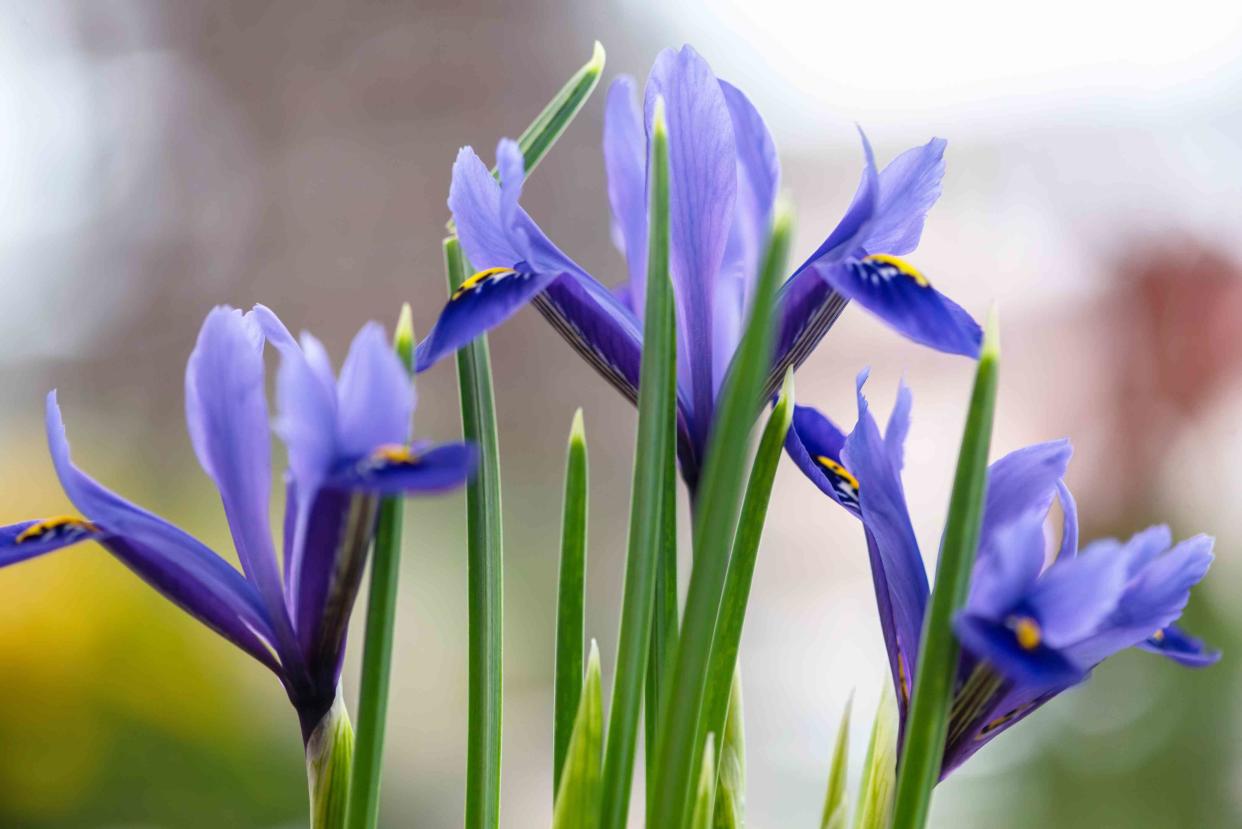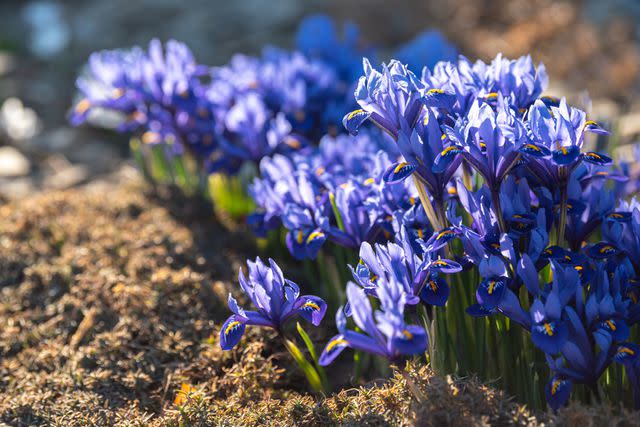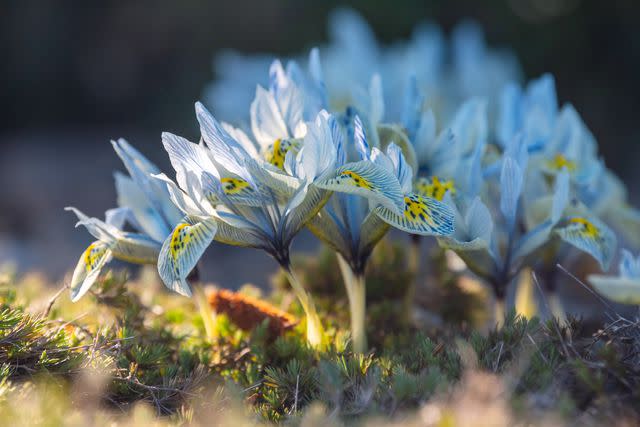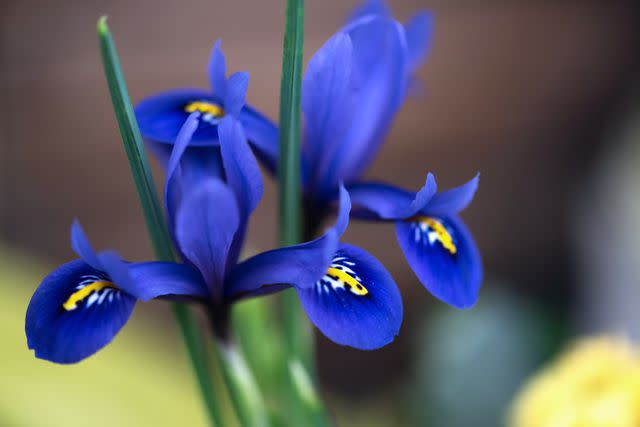How to Grow and Care for Iris Reticulata

The Spruce / Evgeniya Vlasova
Reviewed by Barbara Gillette
Iris reticulata, also known as netted iris or dwarf iris, is a dwarf iris cultivar. This perennial bulb shoots up vibrant 4- to 6-inch tall blooms in the spring. These irises can be planted nearly anywhere, tolerating both full sun and partial shade, and are significantly low-maintenance plants.
It is important to keep in mind that the roots, sap, and seeds of these plants are toxic to both pets and people.
Common Name | Dwarf Iris, netted Iris, reticulated Iris |
Botanical Name | Iris reticulata |
Family | Iridaceae |
Plant Type | Perennial, bulb |
Mature Size | 4-6 in. tall, 4 in. wide |
Sun Exposure | Full, partial |
Soil Type | Well-drained |
Soil pH | Neutral, alkaline |
Bloom Time | Spring |
Flower Color | Purple, blue, white |
Hardiness Zones | 5-9 (USDA) |
Native Area | Middle East |
Toxicity | Toxic to people, toxic to pets |
Iris Reticulata Care
Because of their easy care requirements, Iris reticulata are great bulbs for almost any gardener. Here are the main care requirements for growing them:
Choose a spot with full sun or partial shade and well-draining soil.
Plant in the fall, about four inches deep and three inches apart, with the pointed end facing up.
Water consistently in the spring when the plant is growing, and stop watering in summer when the bulbs go dormant.
If the soil is nutrient-deficient, consider adding some compost each spring.

The Spruce / Evgeniya Vlasova

The Spruce / Evgeniya Vlasova

The Spruce / Evgeniya Vlasova
Light
Iris reticulata bloom best when grown in full sunshine. However, these bulbs with miniature flowers can also be grown in partial shade.
Soil
These irises require well-draining, gravelly soil with consistent moisture levels during the spring. Heavy, soggy, and clay soils will cause problems such as rot. They thrive in neutral to slightly alkaline soil.
Water
Consistent moisture is necessary in the spring, while the plant is actively growing and blooming. During this time, water when the top of the soil begins to feel dry. In summer seasons, these plants prefer dry conditions as they go dormant. Reduce or stop watering when the bulbs are dormant since they can easily rot.
Temperature and Humidity
These hardy bulbs can be grown anywhere in USDA zones 5 to 9. They prefer average humidity levels and require cold winters for excellent spring blooms.
Fertilizer
When planted in high-quality soil, fertilizer is not needed. However, if soil conditions are questionable or poor, you may find it beneficial to add compost in the spring each year.
Types of Iris Reticulata
'Gordon': flowers with a dark purple tongue and a yellow/orange splotch.
'George': dark, thin fuchsia flower petals with yellow and white markings.
'Harmony': smaller royal blue flowers that form a fan-shape.
'Katherine Hodgkin': lighter, striped flower petals that are closer to lavender in shade.
Propagating Iris Reticulata
Propagation can be done through division. This not only provides more iris plants but also benefits the original bunch. Irises can become overcrowded as they multiply each year; after several years, flower production will suffer if they are too tightly packed. Division will help the flowers revive and produce a healthy bloom again. To do this, you will need garden gloves and a hand shovel. Then follow these instructions:
In late summer while the irises are dormant, gently use the hand shovel to dig up the bulbs.
Gently separate the bulbs with your hands.
Plant around half of the bulbs back in their original spot. Be sure the pointed end of each bulb is facing up.
Move the remaining bulbs to their own location.
How to Grow Iris Reticulata From Seed
Iris reticulata can also be grown from seed. However, because this form of propagation does not create an exact clone of the parent plant, the resulting flowers may differ from the original plant. Still, this form of propagation is fun and easy. To do this, you will need iris seeds, a pair of garden gloves, and well-draining soil.
Starting irises from seed is best done outdoors to allow the changing seasons to naturally stratify the seeds. The first step is to identify the ideal location in your garden. An area with well-draining soil and plenty of sunshine is best.
In autumn, gently bury the seeds in the well-draining soil about 3/4 inch deep.
Allow the winter weather to activate the seeds.
Watch for tiny seedlings in the early spring. If they do not sprout the first year, they may still sprout the following year. Patience is key.
Potting and Repotting Iris Reticulata
Their small size and preference for well-draining soil make these bulbs a great choice for container gardens. When choosing a pot, be sure it has free-flowing drainage holes to prevent any standing water. Fill the pot with well-draining soil and plant the iris bulbs around three inches apart from each other.
As more bulbs appear and the irises fill the container, you can either divide the plant or move the bulbs to a larger pot. If you are repotting, be sure the pointed end of each bulb faces up.
How to Get Iris Reticulata to Bloom
Bloom Months
Iris reticulata are early spring bloomers. They flower from March to April in much of the United States.
How Long Does Iris Reticulata Bloom?
While individual flowers only last a few days to a week, the plant will continue to bloom for several weeks.
What Do Iris Reticulata Flowers Look and Smell Like?
They produce vibrant blue or purple flowers with yellow or white details on each petal. Their structure is very similar to larger iris flowers, as they have the iconic shape of three inner, upright petals and three outer, flowing petals. Though small, they have a lightly sweet fragrance.
Caring for Iris Reticulata After It Blooms
After they are finished blooming, the flowers and foliage will fade quickly. You may wish to prune the foliage down to the ground after this happens. The bulbs will go dormant for the rest of the year until the following spring.
Deadheading Iris Reticulata Flowers
Though their bloom time is short, deadheading spent blooms will ensure you get the most out of their season. Doing so will encourage more blooms to appear.
Common Problems With Iris Reticulata
Iris reticulata are hardy plants that have very few problems. This variety is more resistant to iris borers than their larger cousins. Netted irises may run into problems with rot, though this does not happen often.
Soggy, Yellowing, and Wilting Foliage
Especially when it occurs at the base of the iris plant, this is a sign of fusarium basal rot. Cut back on watering, amend the soil with well-draining compost and sand, and remove any infected bulbs and foliage. You may also need to treat the plants with a fungicide and replace some of the infected soil.
Frequently Asked Questions
Is Iris reticulata a perennial?
Yes, these irises are perennial bulbs. They appear each year in the early spring, being one of the first flowers to bloom after winter.
How long do Iris reticulata flower?
These dwarf irises bloom in the early spring for a short time. The exact month may differ depending on your location, but they generally bloom throughout March and into April.
Should you deadhead Iris reticulata?
Yes, feel free to deadhead spent blooms. This will encourage a continual production of healthy flowers throughout its blooming season.
Do deer eat Iris reticulata?
No, this bulb is particularly resistant to deer.
Read the original article on The Spruce.

